Reprogramming cells and tissue patterning via bioelectrical pathways: molecular mechanisms and biomedical opportunities
- PMID: 23897652
- PMCID: PMC3841289
- DOI: 10.1002/wsbm.1236
Reprogramming cells and tissue patterning via bioelectrical pathways: molecular mechanisms and biomedical opportunities
Abstract
Transformative impact in regenerative medicine requires more than the reprogramming of individual cells: advances in repair strategies for birth defects or injuries, tumor normalization, and the construction of bioengineered organs and tissues all require the ability to control large-scale anatomical shape. Much recent work has focused on the transcriptional and biochemical regulation of cell behavior and morphogenesis. However, exciting new data reveal that bioelectrical properties of cells and their microenvironment exert a profound influence on cell differentiation, proliferation, and migration. Ion channels and pumps expressed in all cells, not just excitable nerve and muscle, establish resting potentials that vary across tissues and change with significant developmental events. Most importantly, the spatiotemporal gradients of these endogenous transmembrane voltage potentials (Vmem ) serve as instructive patterning cues for large-scale anatomy, providing organ identity, positional information, and prepattern template cues for morphogenesis. New genetic and pharmacological techniques for molecular modulation of bioelectric gradients in vivo have revealed the ability to initiate complex organogenesis, change tissue identity, and trigger regeneration of whole vertebrate appendages. A large segment of the spatial information processing that orchestrates individual cells' programs toward the anatomical needs of the host organism is electrical; this blurs the line between memory and decision-making in neural networks and morphogenesis in nonneural tissues. Advances in cracking this bioelectric code will enable the rational reprogramming of shape in whole tissues and organs, revolutionizing regenerative medicine, developmental biology, and synthetic bioengineering.
Copyright © 2013 Wiley Periodicals, Inc.
Conflict of interest statement
No conflict of interest.
Figures
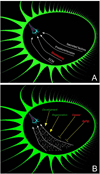
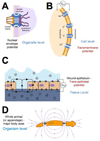
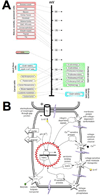
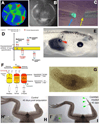
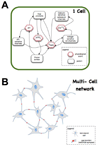
Similar articles
-
Endogenous gradients of resting potential instructively pattern embryonic neural tissue via Notch signaling and regulation of proliferation.J Neurosci. 2015 Mar 11;35(10):4366-85. doi: 10.1523/JNEUROSCI.1877-14.2015. J Neurosci. 2015. PMID: 25762681 Free PMC article.
-
Molecular bioelectricity: how endogenous voltage potentials control cell behavior and instruct pattern regulation in vivo.Mol Biol Cell. 2014 Dec 1;25(24):3835-50. doi: 10.1091/mbc.E13-12-0708. Mol Biol Cell. 2014. PMID: 25425556 Free PMC article.
-
Endogenous bioelectrical networks store non-genetic patterning information during development and regeneration.J Physiol. 2014 Jun 1;592(11):2295-305. doi: 10.1113/jphysiol.2014.271940. J Physiol. 2014. PMID: 24882814 Free PMC article. Review.
-
Endogenous voltage gradients as mediators of cell-cell communication: strategies for investigating bioelectrical signals during pattern formation.Cell Tissue Res. 2013 Apr;352(1):95-122. doi: 10.1007/s00441-012-1329-4. Epub 2012 Feb 17. Cell Tissue Res. 2013. PMID: 22350846 Free PMC article. Review.
-
Endogenous Voltage Potentials and the Microenvironment: Bioelectric Signals that Reveal, Induce and Normalize Cancer.J Clin Exp Oncol. 2013;Suppl 1:S1-002. doi: 10.4172/2324-9110.S1-002. J Clin Exp Oncol. 2013. PMID: 25525610 Free PMC article.
Cited by
-
Built-in microscale electrostatic fields induced by anatase-rutile-phase transition in selective areas promote osteogenesis.NPG Asia Mater. 2016;8:e243. doi: 10.1038/am.2016.9. Epub 2016 Mar 4. NPG Asia Mater. 2016. PMID: 27818718 Free PMC article.
-
Bioelectric regulation of innate immune system function in regenerating and intact Xenopus laevis.NPJ Regen Med. 2017 May 26;2:15. doi: 10.1038/s41536-017-0019-y. eCollection 2017. NPJ Regen Med. 2017. PMID: 29302351 Free PMC article.
-
Synthetic living machines: A new window on life.iScience. 2021 May 4;24(5):102505. doi: 10.1016/j.isci.2021.102505. eCollection 2021 May 21. iScience. 2021. PMID: 34041452 Free PMC article. Review.
-
Endogenous gradients of resting potential instructively pattern embryonic neural tissue via Notch signaling and regulation of proliferation.J Neurosci. 2015 Mar 11;35(10):4366-85. doi: 10.1523/JNEUROSCI.1877-14.2015. J Neurosci. 2015. PMID: 25762681 Free PMC article.
-
Interferon-Gamma Stimulated Murine Macrophages In Vitro: Impact of Ionic Composition and Osmolarity and Therapeutic Implications.Bioelectricity. 2020 Mar 1;2(1):48-58. doi: 10.1089/bioe.2019.0032. Epub 2020 Mar 18. Bioelectricity. 2020. PMID: 32292895 Free PMC article.
References
Publication types
MeSH terms
Substances
Grants and funding
LinkOut - more resources
Full Text Sources
Other Literature Sources
Medical

